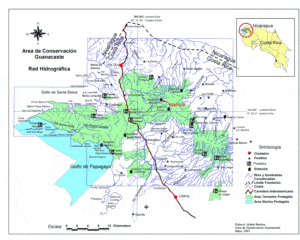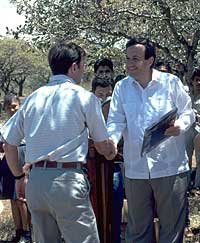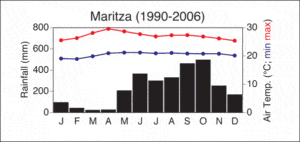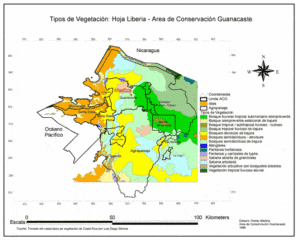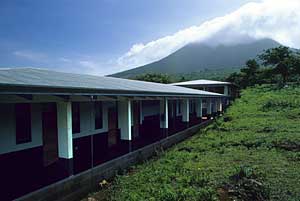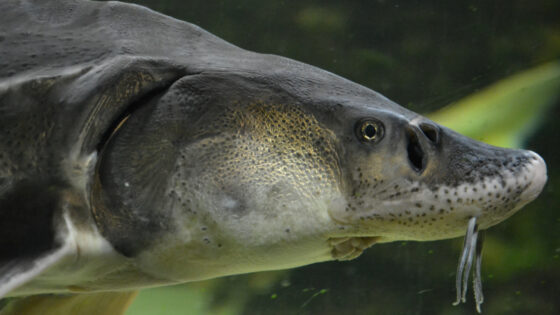Overview
In 1989 Stroud Water Research Center helped establish the Maritza Biological Station in the Área de Conservación Guanacaste of Costa Rica. Located at the base of the Orosí Volcano in the northwest corner of the country, the station is the Stroud Center’s headquarters for the study of tropical ecosystems. It also serves as an information source for Latin American scientists and land managers who are interested in implementing conservation strategies in tropical streams and watersheds.
In 1999, the Área de Conservación Guanacaste (ACG) was inscribed as a UNESCO World Heritage site representing the best dry forest habitats from Central America to northern Mexico. ACG is also the site of the largest forest restoration project in the tropics, with the ultimate goal of reestablishing a major tropical dry forest wildland from large remnants of pristine forest and reclaimed pasturelands.
With the backdrop of a natural and successional mosaic, we established the small to intermediate-size streams of the ACG as a Long-Term Research in Environmental Biology (LTREB) site in the Central American tropical forest.
Área de Conservación Guanacaste
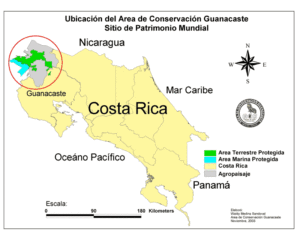
The Área de Conservación (ACG) in northwestern Costa Rica is a large (113,000 terrestrial hectares or ~2% of Costa Rica, with an additional 43,000 marine hectares), permanently conserved, government-owned wildlands in northwestern Costa Rica that is climatically, hydrologically, ecologically, and taxonomically diverse. Its environments range from extensive dry forest in the lowlands and foothills near the Pacific Ocean to cloud forest atop the mountains and rain forest on the Caribbean foothills.
In 1999, the ACG was inscribed as a UNESCO World Heritage site representing the best dry forest habitats from Central America to northern Mexico. ACG is also the site of the largest forest restoration project in the tropics, with the ultimate goal of reestablishing a major tropical dry forest wildland from large remnants of pristine forest and reclaimed pasturelands.
Today, the ACG is a mosaic of successional stages — most mid-elevation (i.e., 200-500 m a.s.l.) hill slopes are still open grasslands/savannahs while other areas have already developed young forests. Extensive changes in species composition and productivity are expected as trees grow and early colonizing species are replaced by slow dispersing and shade tolerant species.
Forest regeneration will make the ACG watersheds not only invaluable biodiversity resources, but irreplaceable reference points for understanding the ecology of former dry forest landscapes that surround the ACG and are being converted and managed as multi-purpose agroforests.
At a time when tropical habitats are increasingly deforested and fragmented, this represents a unique research opportunity to study 100s of kilometers of streams flowing beneath a dry forest canopy.
With the backdrop of a natural and successional mosaic, we established the small to intermediate size streams of the ACG as a LTREB site in the Central American, tropical forest. We will address hypotheses regarding the response of stream ecosystems to large-scale, passive restoration of tropical forests, and to a steep moisture gradient (with spatial and temporal components). These hypotheses build upon the long-term database that Stroud Water Research Center has established for ACG streams, especially near Estación Biológica Maritza.
Maritza Biological Station (Estación Biológica Maritza)
In early 1988 Stroud Water Research Center began to transform a small farm into a biological field station (i.e., Maritza, at 10º 57´ 25″ N, 85º 29´ 42″ W, 590 m), the only research station in the ACG devoted to understanding tropical streams and their watersheds. This location was chosen because provides easy access to numerous permanent and intermittent streams that drain watersheds on the slopes of Volcán Orosí (1450 m a.s.l.) and Volcán Cacao (659 m a.s.l.). These dormant volcanoes define the northern limit of the Cordillera de Guanacaste.
Vegetation immediately adjacent to and upslope of Maritza is characteristic of mid-elevation tropical dry forest that is semi-deciduous during the dry season. Read more about Maritza’s vegetation below.
Stroud Center staff quickly set up research projects and worked with local officials to design and construct the research and living facilities. Under an innovative “debt-for-nature” swap orchestrated by The Nature Conservancy and the Costa Rican government, the Stroud Foundation and the Stroud family and friends provided the funds to construct and equip five buildings on the site.
When President Rafael Calderón dedicated Maritza as a permanent research facility in 1991, Stroud Center staff already had intensive long-term investigations under way on six streams that drain the area’s virgin forest.
The ongoing research at Maritza includes detailed studies of hydrology, biogeochemistry, microbiology, organic chemistry, organic food inputs, population and community ecology, pesticide analyses and genetics.
In the process of pursuing our ecological questions and the assistance of our colleagues in aquatic insect systematics, we have discovered numerous new species and associated named adults with previously undescribed larval stages that live in these streams.
Our work on pristine streams near Maritza forms a baseline foundation from which we are now asking fundamental questions about streams in other environments throughout Costa Rica.
Climate at Maritza
Climatic diversity is a major contributor to the large diversity of ecosystems found in the ACG. They range from the cool, moist cloud forests atop the mountains that separate the hot, dry (<1000 mm rain per year) plains near the Pacific Ocean and the warm, wet (>3000 mm of rain per year) lowland rain forests of the Caribbean.
Based on data from 1990-2006, Maritza has a strong seasonal climate — total rainfall averaged 2748 mm/yr (9 feet/yr), with 93% of total precipitation occurring during an ~8-month wet season (May-Dec; > 100 mm rain per month) and only 7% during a 4-month dry season (Jan-Apr). Sep (460 mm) and Oct (472 mm) are the wettest months, and Mar (23 mm) and Apr (29 mm) are the driest months. Air temperature also exhibited a seasonal pattern, albeit not as dramatic as for rainfall. Maximum air temperature at Maritza averaged 27.2ºC (81ºF) while minimum air temperature averaged 20.4ºC (69ºF), a difference of only 6.8ºC (12ºF). Apr (max= 29.5ºC; min= 20.8ºC) and May (max= 28.7ºC; min= 21.1ºC) were the warmest months while Dec (max= 25.5ºC; min= 19.9ºC) and Jan (max =25.6ºC; min= 18.9ºC) were the coolest months.
Wind velocity has not been measured, but can be extremely high during the dry season months of January through March. These winds reflect an orographic interaction between the northeast trade winds and the Cordillera de Guanacaste.
Meterological data were collected manually at Maritza with daily records of maximum and minimum air temperature and total precipitation (24 h period beginning at 0700 h). Daily air temperature and precipitation (collected manually) span 1990 to present. Air temperature and precipitation at Santa Rosa are also available from the ACG (1979-present), while the Stroud Water Research Center has collected precipitation data (1998-present) and air temperature (2006-present) at San Cristóbal between Volcán Cacao and Volcán Rincón de la Vieja.
Vegetation at Maritza
Vegetation immediately adjacent to and upslope of Maritza is characteristic of mid-elevation tropical dry forest that is semi-deciduous during the dry season; vegetation at higher elevations in the watersheds transition into rain and cloud forests. Lowland dry forests are almost completely deciduous while higher elevation rain and cloud forest are evergreen.
There are no visible signs of anthropogenic disturbance in the primary forest above Maritza. Much of the land downslope from the station has been cleared and was maintained as grazing land by annual burning until inclusion in the Parque Nacional Guanacaste in 1987. Even in these cleared areas, mature riparian forests were traditionally maintained along most perennial and ephemeral stream corridors.
Stream Research and Data
Estación Maritza is located near the banks of the Río Tempisquito and within easy walking distance of five other permanent streams that are all tributaries of the Río Tempisque.
These streams have been the focus of many of our studies of stream ecology and biogeochemistry. Our efforts have also extended to permanent and temporary streams near other research facilities such as Santa Rosa, Cacao, San Cristóbal, and Pitilla.
Characteristics of the Six Study Catchments Initially Studied Near Maritza
| Stream | Catchment area (km2) | Mean streamflow (m3/s) | Run-off (m/yr) | Elevation range (m) |
|---|---|---|---|---|
| Río Tempisquito | 3.19 | 0.30 | 2.9 | 580-1340 |
| Río Tempisquito Sur | 3.11 | 0.42 | 4.3 | 580-1250 |
| Quebrada Kathia | 2.64 | 0.26 | 3.1 | 600-1540 |
| Quebrada Marilin | 0.36 | 0.018 | 1.6 | 590-880 |
| Quebrada El Jobo | 0.55 | 0.025 | 1.4 | 590-1040 |
| Quebrada Zompopa | 0.37 | 0.033 | 2.8 | 600-1100 |
Data Collected Regularly Since 1990
- Air temperature
- Seston
- Rainfall
- Litter and leaf
- Stream discharge/ stage height
- Adult aquatic insect collections
- Water temperature
Data Collected at Various Times and Frequencies
- Inorganic nutrients
- Carbohydrate molecules
- Base cations
- Amino acid molecules
- Anions
- Tetramethyl ammonium hydroxide GC/MS profiles
- pH
- Pesticides
- Alkalinity
- Bacterial densities
- Conductivity
- Bacterial species (TRFLP profiles)
- Dissolved organic carbon
- Diatom species list and densities
- Biodegradable DOC
- Larval aquatic insect collections
Accessing the Data
We are happy to share data collected for this project and to collaborate in its interpretation. Proposals for collaboration should be directed to John Jackson.
To access the data, please submit this form.
Visiting Maritza
The facilities at Maritza include two research laboratories dedicated to stream research, two large, multi-purpose classrooms, and a dormitory that can house 32 people in four large rooms with showers and bathrooms. Potable water and electricity (110 v) are continuously available. Contact with ACG officials is maintained by radio and cellular telephone. No public telephone and internet access are provided. The nearest medical hospital is in Liberia.
Students, teachers, researchers, and ecotourists are all welcome for day and overnight visits to Maritza. However, visits require permission of the ACG and reservations. This helps insure the availability of support staff and dormitory and dining facilities, and safe journeys to and from this remote station. For more information, contact John Jackson, Ph.D.
Investigators
More than two dozen investigators from Stroud Water Research Center and 14 other institutions that have worked on the LTREB Costa Rica study, and a considerable number of peer-reviewed publications have resulted from it (see below).
Stroud Water Research Center
Past investigators with Stroud Water Research Center:
- Anthony Aufdenkampe
- Carlos de la Rosa
- Laurel J. Standley
- Robin L. Vannote
Investigators with other affiliations
- Arturo Sánchez-Azofeifa, University of Alberta
- Julio C. Calvo, Instituto Tecnologico de Costa Rica
- R. Wills Flowers, Florida A & M University
- Leo Füreder,University of Innsbruck
- Ralph W. Holzenthal, University of Minnesota
- Roger J. Blahnik, University of Minnesota
- Bill P. Stark, Mississippi College
- William P. Coffman, University of Pittsburgh
- John H. Epler and Gordon Pritchard, University of Calgary
- Eduardo Domínguez, Universidad Nacional de Tucumán
- Carlos Molineri, Universidad Nacional de Tucumán
- Oliver S. Flint, Smithsonian Institution
- Atilano Contreras-Ramos, UAEH, Pachuca, Mexico
- Fernando Muñoz-Quesada, University of Minnesota
- W. Patrick McCafferty, Purdue University
- Robert W. Waltz, Indiana Division of Entomology
Publications
Authored/Co-Authored by Stroud Center Scientists
Authored by Scientists from Other Institutions
Amit-Rojas, R. 2006. El jaguar (Panthera onca) en el sector San Cristóbal del Área de Conservación Guanacaste, Costa Rica, densidad, abundancia de presas y depredación de ganado. Tesis, Mag. Sc., Universidad Nacional, Programa Regional en Conservación y Manejo de Vida Silvestre para Mesoamérica y El Caribe, Heredia (Costa Rica).
Amit, R. 2011. El jaguar en el Sector San Cristóbal, Guanacaste-Costa Rica: Densidad, abundancia de presas y depredación de ganado. Académica Española. 56 pages. ISBN-10: 3845497114
Baumgardner, D. E. and W. P. McCafferty 2000. Leptohyphes zalope (Ephemeroptera: Leptohyphidae): A polytypic North and Central American species. Entomological News 111(1): 49-59.
Brookshire, E. N. J., L. O. Hedin, J. D. Newbold, D. M. Sigman, and J. K. Jackson. 2012. Sustained losses of bioavailable nitrogen from montane tropical forests. Nature Geoscience 5:123-126.
Calvo-Alvarado, J., Jiménez-Rodríguez, C., and de Saá-Quintana, M. 2012. Intercepción de precipitación en tres estadios de sucesión de un Bosque húmedo Tropical, Parque Nacional Guanacaste, Costa Rica. Revista Forestal Mesoamericana Kurú 9(22):1-9.
Calvo-Alvarado, J. C. 2013. Valoración y Planificación del Recurso Hídrico en la cuenca alta y canal principal del río Tempisque. Instituto Tecnológico de Costa Rica.
Coffman W. P., C. De La Rosa, K. W. Cummins and M. A. Wilzbach. 1992. Species richness in some Neotropical (Costa Rica) and Afrotropical (West Africa) lotic communities of Chironomidae (Diptera). Netherlands Journal of Aquatic Ecology 26:229-237.
Coffman, W.P. and C.L. de la Rosa. 1998. Taxonomic composition and temporal organization of tropical and temperate species assemblages of lotic Chironomidae. Journal of the Kansas Entomological Society 71:388-406.
de la Rosa, C.L. 1992. Phoretic associations of Chironomidae (Diptera) on Corydalidae (Megaloptera) in northwestern Costa Rican streams. Journal of the North American Benthological Society 11:316-323.
de Saá-Quintana, Miquel 2008. Intercepción de la precipitación en tres estadios de sucesion del Parque Nacional Guanacaste, Costa Rica. Thesis, Tesis para optar por el grado de Licenciado en Ingenieria Forestal, Instituto Tecnoligico de Costa Rica, Escuela de Ingenieria Forestal, Cartago, Costa Rica.
Epler, J.H. & C.L. de la Rosa. 1995. Tempisquitoneura, a new genus of Neotropical Orthocladiinae (Diptera: Chironomidae) symphoretic on Corydalus (Megaloptera: Corydalidae). Journal of the North American Benthological Society 14: 50-60.
Füreder L. 1994. Drift patterns in Costa Rica streams. Ph.D. Thesis, Innsbruck University, Austria
Gotsch, S.G. 2006. Seasonal water stress and leaf traits in the tropical forests of northwestern Costa Rica. Ph.D. Dissertation, State University of New York, Stony Brook
Gotsch, S.G., J.S. Powers and M.T. Lerdau. 2010. Variation in leaf traits of 12 evergreen species that grow in Costa Rican wet and dry forests: shifting leaf-trait networks and novel leaf-trait relationships. Plant Ecology 211:133-146.
Guzmán-Arias, I. and J. C. Calvo-Alvarado. 2013. Planificación del recurso hídrico en América Latina y el Caribe. Tecnología en Marcha (Costa Rica) 26:3-18
Guzmán Arias, I., and Calvo Alvarado, J. C. 2012. Recursos hídricos de la Cuenca Alta del Rio Tempisque, Costa Rica (nota técnica). Tecnología en Marcha (Costa Rica) 25(4), 63-70.
Holzenthal, R.W. 1995. The caddisfly genus Nectopsyche: new gemma group species from Costa Rica and the Neotropics (Trichoptera:Leptoceridae). Journal of the North American Benthological Society 14(1): p. 61-83.
Holzenthal, R. W. and R. J. Blahnik. 1995. New species of Smicridea (Rhyacophylax)(Trichoptera: Hydropsychidae) from Costa Rica. Entomological News 106(5): 212-223.
Jiménez-Rodríguez, C. 2010. Intercepción de lluvia en tres estadios sucesionales del Bosque seco Tropical, Parque Nacional Santa Rosa, Costa Rica. Thesis: Tesis para optar por el grado de Licenciado en Ingeniería Forestal. Instituto Tecnológico de Costa Rica, Escuela de Ingenieria Forestal, Cartago, Costa Rica.
Molineri, C. 2004. Phylogeny of the Allenhyphes-Traverhyphes group (Ephemeroptera: Leptohyphidae), with new subgenera, species and combinations. Tijdschrift voor Entomologie 147: 197-220.
Molineri, C. 2006. Phylogeny of the mayfly family Leptohyphidae (Insecta : Ephemeroptera) in South America. Systematic Entomology 31(4): 711-728.
Muñoz-Quesada, F. 1997. Five new species and a new record of Costa Rican Leptonema Guerin (Trichoptera: Hydropsychidae). Proceedings of the Entomological Society of Washington 99(1): 115-132.
Pritchard, G. 1996. The life history of a tropical dragonfly:Cora marina (Odonata: Polythoridae) in Guanacaste, Costa Rica. Journal of Tropical Ecology Vol. 12:573-581.
Stark, B. P. (1998). The Anacroneuria of Costa Rica and Panama (Insecta: Plecoptera: Perlidae). Proceedings of the Biological Society of Washington 111(3): 551-603.
Waltz, R. D. and W. P. McCafferty 1999. Additions to the taxonomy of Americabaetis (Ephemeroptera : Baetidae): A. lugoi, n. sp., adult of A. robacki, and key to larvae. Entomological News 110(1): 39-44.
Support
Support for this site was provided by National Science Foundation Grant DEB 05-16516 to Drs. John K. Jackson, Louis A. Kaplan, J. Denis Newbold, Thomas L. Bott, and Anthony Aufdenkampe.
This grant is part of the NSF program for Long-Term Research in Environmental Biology (LTREB), which promotes the further development of established long-term environmental monitoring research. If you would like to learn more about the NSF-LTREB program, visit their website.

